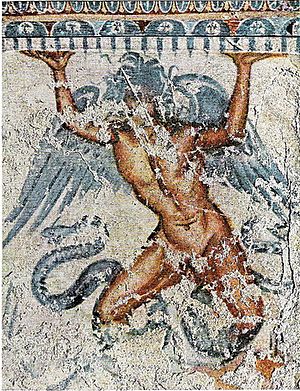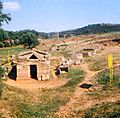Etruscan mythology facts for kids

The Etruscans were an ancient people who lived in central Italy. Their culture was very important before the rise of Rome. Many of their gods and goddesses later became part of the Roman gods we know today.
We don't have much writing from the Etruscans. Only a few short texts and some writings on graves have survived. Because of this, we don't understand the Etruscan language very well. The Romans wrote about the Etruscans, but sadly, most of those writings are now lost.
The three most important Etruscan gods were Tinia, Uni, and Menrva.
Etruscan Gods and Heroes
The Etruscans had many gods, goddesses, and heroes. Here are some of the most well-known ones:
| Name | Information | |
|---|---|---|
| Achle | A brave hero from the Trojan War, similar to the Greek Achilles. | |
| Aita | Also Eita. He was the god of the underworld and ruler of the dead. He was like the Greek god Hades and the Roman god Pluto. | |
| Aivas | Also Eivas or Evas. This was the Etruscan name for the Greek heroes Ajax, son of Telamon and Ajax, son of Oileus. | |
| Alpan | Also Apanu. A goddess of love and one of the Lasas. She also had a role in the underworld. She might be similar to the Greek goddess Persephone. | |
| Ani | A sky god who lived in the highest part of the heavens. His name might be connected to the Roman god Janus. He also had a female partner named Ana. | |
| Aplu | Also Apulu. This god was linked to thunder and lightning. He was often shown with a staff and laurel branches. He came from the Greek god Apollo. | |
| Artume | Also Aritimi, Artumes or Artames. She was the goddess of the night, the moon, and death. She also looked after nature, forests, and fertility. She was similar to the Greek goddess Artemis. | |
| Atunis | Also Atuns. This was the Etruscan name for Adonis, a god linked to life, death, and rebirth. He was the partner of Turan. | |
| Cautha | Also Cath or Catha. She was a sun goddess and was seen as the daughter of the sun. She was also the goddess of new beginnings and the dawn. Sometimes, she was shown rising from the ocean. | |
| Cel | Also Cilens or Celens. This was an earth god, much like the Greek goddess Gaia. He was sometimes called Ati Cel ("Father Earth") or Apa Cel ("Mother Earth"). | |
| Charun | Also Karun. This was a demon who tormented dead souls in the underworld. He also guarded the entrance to the underworld. He was often painted as a blue monster with a vulture's nose, pointed ears, and red hair. He sometimes had feathered wings and used a hammer or axe. He was similar to the Greek god Charon. | |
| Culsans | The god of doors and doorways. He was like the two-faced Roman god Janus. | |
| Culsu | Also Cul. A female underworld demon who liked gateways. She often carried a torch and scissors. She was often shown next to Culsans. | |
| Easun | This hero was the same as the Greek legendary hero Jason. | |
| Evan | A god of personal immortality. He was one of the Lasas. | |
| Februus | The god of the dead and purification. The Romans also worshipped him during the Februalia festival. The month of February was named after him. | |
| Fufluns | Also Puphluns. He was the god of plants, happiness, health, and growth. He was the son of Semia. He was similar to the Greek god Dionysus (also known as Bacchus). | |
| Hercle | Also Herc or Horacle. This hero was the same as the legendary Greek hero Heracles and the Roman hero Hercules. He was known for strength and water. | |
| Horta | The goddess of farming and agriculture. | |
| Laran | The god of war. In art, he was usually shown as a young man with a helmet and spear. Laran's partner was Turan, the goddess of love. He was like the Greek god Ares. | |
| Lasa | (Plural: Lasas). These were gods and goddesses who were with Turan, the goddess of love. They also guarded graves. | |
| Lasa Vecu | A goddess of prophecy, similar to the nymph Vegoia. | |
| Leinth | A goddess with no face who waited at the gates of the underworld with Aita. | |
| Lethans | Also Letham. A protector goddess of the underworld. | |
| Losna | Also Lusna. She was a Moon goddess who was also linked to the ocean and tides. She is probably similar to the Greek goddess Leucothea. | |
| Mania | The goddess of the dead in Etruscan and Roman stories. She ruled with Mantus and was seen as the mother of ghosts and other spirits of the night. | |
| Mantus | The god of the underworld and husband of Mania. The city of Mantua might have been named after him. | |
| Maris | A god of farming and fertility. He was also seen as a savior god. | |
| Menrva | Also Menarva. She was the goddess of wisdom, war, art, and trade. She was like the Greek goddess Athena and the Roman goddess Minerva. Like Athena, Menrva was said to be born from the head of her father, Tinia. Menrva, Tinia, and Uni were the three most important ruling gods. | |
| Nethuns | The god of wells. Later, he became the god of all water, including the sea. He was like the Greek god Poseidon and the Roman god Neptune. | |
| Nortia | The goddess of fate and chance. A nail was put into a wall in her temple during the Etruscan new year festival. | |
| Persipnei | Also Ferspnai. She was the Queen of the underworld, similar to the Greek Persephone and Roman Proserpina. | |
| Satres | The god of time and necessity. He was shown as an old man carrying a sickle and an hourglass. He was like the Roman god Saturn. | |
| Selvans | Also Selva. He was a god of woodlands, similar to the Roman god Silvanus. | |
| Semla | An earth goddess and the mother of Fufluns. She might be similar to the Greek goddess Semele. | |
| Sethlans | Also Velchans. He was the god of fire and the forge, often carrying an axe. He was like the Greek god Hephaestus and the Roman god Vulcan. | |
| Tages | Also Tarchies. He was a god of wisdom. He was said to appear during ploughing time and taught the Etruscans how to tell the future. He was sometimes shown with two snakes for legs. | |
| Taitle | The Etruscan version of the Greek hero Daedalus. | |
| Tarchon | An Etruscan hero who, with his brother Tyrrhenus, helped found the Etruscan Federation of twelve cities. | |
| Tecum | The god of the lucomenes, who were Etruscan rulers. | |
| Thalna | The goddess of childbirth and the wife of Tinia. She was often shown as a young woman in art. | |
| Thesan | The goddess of the dawn. She was similar to the Roman Aurora and the Greek Eos. | |
| Thethlumth | A god of fate and the underworld. | |
| Thufltha | Or Thuflthas. She was a fury who punished people for Tinia. | |
| Tinia | Shortened to Tins. He was the most important Etruscan god, the ruler of the skies, husband of Uni, and father of Hercle. He was very similar to the Greek god Zeus and the Roman god Jupiter. | |
| Tiv | Or Tivr. A moon god. | |
| Tuchulcha | A female demon of the underworld. She was part human and part donkey, with snake hair and a vulture's beak. | |
| Turan | The goddess of love and healthy life. She was also a protector of the Etruscan city of Vulci. She was usually shown as a young winged girl in art. Pigeons and black swans were her special animals. She was similar to the Greek Aphrodite and the Roman Venus. | |
| Turms | The god of trade and messages, and a messenger for the gods. One version of him, Turns Aitas, led the dead. He was often shown with winged shoes and a special hat, very similar to Hermes and Mercury. | |
| Tvath | The goddess of resurrection and love for the dead, similar to the Greek Demeter. | |
| Tyrrhenus | An Etruscan hero and the twin brother of Tarchon. | |
| Uni | The main goddess of the Etruscan pantheon. She was the wife of Tinia, mother of Hercle, and protector of Perugia. With Tinia and Menrva, she was one of the three most important gods. Uni was like the Roman Juno and the Greek Hera. | |
| Usil | The sun god, like the Greek Helios. | |
| Vanth | A demoness from the underworld with winged eyes. She was seen as an all-knowing messenger of death. She helped people who were dying. In art, she was shown with snakes, torches, and keys. | |
| Veive | The god of revenge and a friend of Maris. In art, he was shown as a young man holding a laurel wreath and arrows, standing next to a goat. | |
| Veltha | Also Voltumna. An earth god who later became a very important Etruscan god. He was the protector of the Etruscans. He was like the Roman god Vertumnus. | |
| Vetis | An underworld god of death and destruction. | |
| Vicare | The son of Taitle, similar to the Greek Icarus. |
Images for kids
-
A rare Etruscan temple found at Orvieto.
-
A burial home at Banditaccia with stone couches.
-
A sarcophagus (stone coffin) from Siena.
See also
 In Spanish: Mitología etrusca para niños
In Spanish: Mitología etrusca para niños












